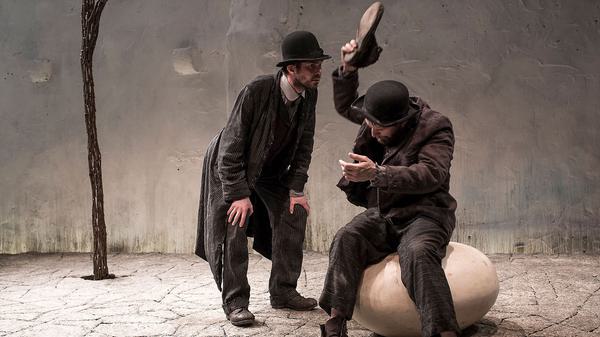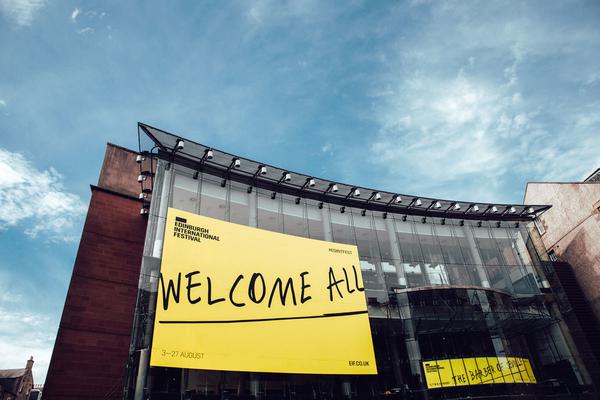
News Story
What does Waiting for Godot have to do with climate change? In this guest blog post, Catriona Patterson of Creative Carbon Scotland says we should stop waiting and take green action.
There is man in his entirety, blaming his shoe when his foot is guilty.Samuel Beckett, Waiting for Godot

Waiting for Godot: An Allegory for Climate Change?
This year, the International Festival is hosting a production of the funny, poetic, and always intriguing Waiting for Godot. Produced by Druid, and directed by Garry Hynes, Beckett’s masterpiece is famously a play about nothing. About waiting and expectation, about faith and delusion, about inevitability and the unknown, but ultimately about inaction.
The challenge of climate change is not dissimilar. We have known for decades that our fossil-fuelled lifestyles produce greenhouse gases that have an impact on our planet and yet, as a society, we have been guilty of waiting for something, some new knowledge or technology to arrive, to solve a problem of our own making.
We may still wish to wait for our collective ‘Godot’, but climate change has very much already arrived. In Scotland, predictions can be characterised by milder and wetter winters, warmer summers, reduced snowfall, rising sea levels and much more variable weather. And these changes are increasingly immediate: they will be experienced by all those alive today. We are already experiencing 27% more rainfall in Scotland than we did in the 1960s (when the International Festival was a mere teenager!) and temperatures of the recent heatwave are the warmest recorded since records began in 1910.
These changes have far reaching implications for how and where we live, how we grow and source our food, the security of our energy supply, the way we travel our landscape, and the resilience of our heritage and culture. It might mean we can host more events outdoors in the future, but it also might mean that we have to be prepared for more extreme storms, for overheated venues, and for weather-caused travel chaos that challenge the ability of artists and audiences to attend festivals and events.
Yet, amongst the frustration of Waiting for Godot, there are glimmers of opportunity and agency within the play:
“Let us do something, while we have the chance! It is not every day that we are needed. Not indeed that we personally are needed. Others would meet the case equally well, if not better. To all mankind they were addressed, those cries for help still ringing in our ears! But at this place, at this moment of time, all mankind is us, whether we like it or not. Let us make the most of it, before it is too late!”
Similarly, although climate change is inevitable, the intensity of its impact (and our response) is not. Our arts and culture are crucial to understanding and challenging a society in transition: to harness the power of artistic programming to encourage audiences to think differently, and to demonstrate to Scotland, and the wider world, the responsibility that we have to each other.

Greening the Yellow
The International Festival brings together creators, performers and audiences from around the globe. From its post-war beginnings, it has always sought to showcase and innovate, and environmental sustainability is an area of development for cultural events and festivals in Scotland and abroad.
As part of the Edinburgh Festivals Environmental Sustainability Working Group, the International Festival has been working on reducing its environmental impact and increasing its environmental sustainability since 2011. An internal Green Team, made up of staff known as ‘Green Champions’, works to reduce the emissions caused by the energy, water and travel needed by the International Festival, and the waste produced.
Sustainability is embedded in all staff training and thus reaches all aspects of the organisation – from the separation and recycling of 100% of waste in their year-round offices, to training guest drivers in fuel-efficiency, to maximise the utility and minimise the impact of their travel. As well as work behind the scenes, productions such as 2015’s Antigone, and Wind Resistance in 2016, bring issues of morality and ecology to the global public.
Sustainability in Collaborations with the Cultural Sector
No festival exists in a vacuum, and the International Festival is playing its part in the green arts movement taking place across Scotland. Working in collaboration is a key way in which sustainability efforts can be maximised.
In 2013, the Edinburgh Festivals began the ‘Green Venue Guide’: a pamphlet which explained how their partner venues could participate in sustainability efforts. It has since developed into the Green Arts Initiative: an interactive and networked community of practice, made up of over 200 cultural organisations, companies and festivals across Scotland, and is facilitated by culture and sustainability charity Creative Carbon Scotland.
The International Festival venues The Queens Hall, King’s Theatre, The Lyceum, Festival Theatre, Usher Hall and The Hub are all members of the Green Arts Initiative, and work year-round on their environmental sustainability efforts – from providing sustainable travel advice to audiences, to hosting beehives on their roof for enhanced biodiversity!
Many of the Scottish companies performing at the International Festival are also part of the Green Arts Initiative, among them the Royal Scottish National Orchestra (RSNO), National Theatre of Scotland, Scottish Chamber Orchestra, National Youth Choir of Scotland, National Youth Orchestra of Scotland and Hebrides Ensemble. Each are contributing to the 2018 edition of the International Festival, and to the environmental sustainability movement through the way they make and present their work year-round.

Edinburgh: The Green Festival City
Of course, Edinburgh itself is a constant source of inspiration when it comes to environmental matters: 49.2% of the city is green space, with Princes Street Gardens, Arthur’s Seat, Calton Hill, Charlotte Square Gardens, the Meadows and Inverleith Park being just a few of the parks and gardens. There are 638,000 trees in the city, and its architectural heritage has been shaped by the geological and geographical boundaries of being located on top of a volcano, on the estuary of the Forth river. Many of these spaces often double as cultural venues – home to the Virgin Money Fireworks Concert, and events across Edinburgh’s major festivals including the Edinburgh Festival Fringe, the Edinburgh International Book Festival, and the Edinburgh Art Festival.
As a city, it is also ambitious in its sustainability reach: a bike hire scheme will begin in Autumn 2018, enabling locals and visitors to traverse the city using active travel; a community energy solar-cooperative uses green energy produced from solar panels on the roofs of public and civic buildings; and public, private and third sector organisations from across the city have combined forces on an action plan for readying the city for the impacts of climate change.
Spurred by Godot
The futility presented in Waiting for Godot serves not as a demonstration of our current approach to the climate crisis, but rather a reminder of why action to increase and enhance environmental sustainability is quite so important: for festivals, for culture, and for us all.
“Was I sleeping, while the others suffered? Am I sleeping now? Tomorrow, when I wake, or think I do, what shall I say of today?”Samuel Beckett, Waiting for Godot